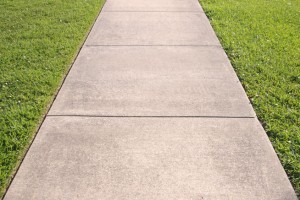I’ve been thinking a lot about concrete lately. Mainly, I’ve been thinking about the lack of concrete here in Boulder compared to Houston, where I lived for four years until May this year. As I’m training for a half-marathon, my knees are particularly grateful for the lack of concrete they’ve experienced of late.
We’ve also thought about concrete and microbes quite a bit on microbe.net. We’ve discussed how bacteria sense and repair concrete as well as lead to concrete corrosion. We’ve also highlighted “green” concrete, made from bacteria and sand (see post here). It seems as though bacteria and concrete live in a love-hate relationship. Sometimes bacteria appear to harm concrete, sometimes they appear to help it.
I recently stumbled across a study that is now a year old. In 2011, a research group revealed their idea to create “BacillaFilla,” a strain of Bacillus that would release calcium carbonate to strengthen concrete (see post here). While this group had yet to engineer this bacterial strain, another group successfully strengthened concrete by adding Sporosarcina pasteuriii, which precipitates calcium carbonate, to the mix (see Open Access article here).
All of this thinking about concrete and bacteria has got me wondering-how can we maximize the love part of the relationship while minimizing the hate part of the relationship? Perhaps scientists can add multiple types of bacteria to concrete mixtures-those that precipitate calcium carbonate and those that inhibit the corrosive activity of other bacteria that find their way into concrete, creating “super strong and durable” concrete. I don’t know for sure where the future of bacteria and concrete research is headed, but I’m excited to find out!
Who knows, maybe scientists can even engineer a bacteria mix to make concrete cushier without making it weaker, saving knees of runners in concrete laden cities everywhere-ok, wishful thinking…
As always, comments and discussion are welcome!

Do you know if any of these studies have addressed whether the bacteria can “escape” from the concrete in any way and get into other materials. Seems unlikely to be a problem but in bioremediation work many people have been concerned with how released bacteria might impact the environment if they spread from their initial release.
That is indeed a very intriguing question. I don’t know if any groups have studied whether bacteria can “escape” concrete, though my hunch is no. Something to look into if Green Concrete really takes off!
There is a natural microflora already living on concrete, both outdoors and indoors. If you do consider these in your plan, including potential interactions of your kind strain with the autochtonous communities, you can get into big, big trouble. Besides, you do not want to wet indoor concrete to get your bacterial strain functional? My advice is: do not introduce new germs on already colonized surfaces until you have considered all the consequences.
That is a great point, and it would have been nice to see whether/how the addition of calcium carbonate releasers to the concrete affected the “native” concrete microbial population. Clearly there is a lot that can still be studied in terms of concrete and bacteria, and I really look forward to seeing what will be discovered…
If you do NOT consider…